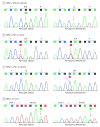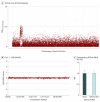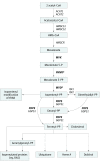Second-Hit, Postzygotic PMVK and MVD Mutations in Linear Porokeratosis
- PMID: 30942823
- PMCID: PMC6506890
- DOI: 10.1001/jamadermatol.2019.0016
Second-Hit, Postzygotic PMVK and MVD Mutations in Linear Porokeratosis
Abstract
Importance: Linear porokeratosis features linear and whorled configurations of keratotic papules and plaques, with coronoid lamellae present on histologic examination. Because linear porokeratosis manifests in the lines of Blaschko representing the dorsoventral migration patterns of keratinocyte precursors, it has been suggested that postzygotic somatic mutation underlies the disease. However, no genetic evidence has supported this hypothesis to date.
Objective: To identify genetic mutations associated with linear porokeratosis.
Design, setting, and participants: Paired whole-exome sequencing of affected skin and blood/saliva samples from 3 participants from 3 academic medical centers with clinical and histologic diagnoses of linear porokeratosis.
Interventions or exposures: Whole-exome sequencing of paired blood/saliva and affected tissue samples isolated from linear porokeratosis lesions.
Main outcomes and measures: Germline and somatic genomic characteristics of participants with linear porokeratosis.
Results: Of the 3 participants, 2 were male. Participant ages ranged from 5 to 20 years old. We found a combination of a novel germline mutation and a novel somatic mutation within affected tissue in all cases. One participant had a germline heterozygous PMVK c.329G>A mutation and a somatic copy-neutral loss of heterozygosity confined to the lesional skin, while a second had a germline heterozygous PMVK c.79G>T mutation and an additional PMVK c.379C>T mutation in the lesional skin. In a third participant, there was a germline splice-site mutation in MVD (c.70 + 5G>A) and a somatic deletion in MVD causing frameshift and premature codon termination within the lesional skin (c.811_815del, p.F271Afs*33 frameshift).
Conclusions and relevance: Our findings suggest that linear porokeratosis is associated with the presence of second-hit postzygotic mutations in the genes that encode enzymes within the mevalonate biosynthesis pathway, and provide further evidence that the mevalonate pathway may be a potential target for therapeutic intervention in porokeratosis.
Conflict of interest statement
Figures




Comment in
-
Molecular Corroboration of Type 2 Segmental Mosaicism in Various Types of Porokeratosis.JAMA Dermatol. 2019 May 1;155(5):531-532. doi: 10.1001/jamadermatol.2019.0134. JAMA Dermatol. 2019. PMID: 30942834 No abstract available.

